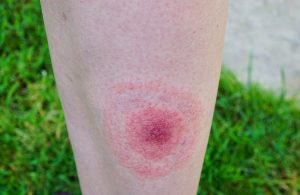Dr. Pamela Smith talked about Lyme disease the great imitator when she gave a presentation. This was at the 25th Congress of the American Academy of Anti-Aging Medicine, Dec. 14-17, 2017, which I attended. Dr. Smith gave a talk about how to approach a complex patient when multiple systems are affected. Part of that talk dealt with Lyme disease, which I will review below in some detail.
Transmission of Lyme disease
Lyme disease is one of the fastest growing infectious diseases in the US. As a result about 200,000 new cases of Lyme disease occur in the US every year.
The transmission occurs through ticks that that carry a spirochete, called Borrelia burgdorferi.
This bacterium, much as syphilis, which also is caused by a spirochete, produces imitator disease patterns. Clinically it can be a challenge to diagnose Lyme disease.
The common way of transmission to humans is by infected ticks that bite the skin. But Dr. Smith said that transmission of the spirochete can also occur by breastfeeding, blood transfusions, in vitro fertilization and finally by sex. Although originally Lyme disease infected ticks were found on deer, other species can also be carriers. Ticks from mice, foxes, raccoons, songbirds, chipmunks, and squirrels can also transmit Lyme disease.
Clinical presentation of Lyme disease
Only 30 – 40% of adults with Lyme disease have the characteristic rash of the “bull’s-eye lesion” (erythema migrans). With children this presentation is even less common (only 10% have erythema migrans). If there is a bull’s-eye lesion, this will last from one week to several months. A laboratory test using an enzyme-linked immunosorbent assay (ELISA test) can confirm the diagnosis of the disease.
Disseminated early or late Lyme disease
Fatigue, headaches and weakness can be non-specific symptoms of Lyme disease. Furthermore, other non-specific symptoms like back pain, muscle and joint pains as well as chills can detract the physician from diagnosing Lyme disease. In addition irregular heartbeats, nausea, vomiting, swollen lymph glands, memory loss, gait problems, bladder and kidney problems are other symptoms. Finally, liver problems, sore throat, fever, seizures, depression, dementia, hallucinations, mood swings and arthritis can be other symptoms.Even eating disorders, verbal aggression, schizophrenia and suicide can be symptoms of Lyme disease.
Common symptoms that have a link to Lyme disease
Common symptoms of Lyme disease include headaches, fatigue, joint pain and swelling of joints, stiffness of the neck or back. There can be difficulties with concentration, speech or writing. Further symptoms are sleep disturbances, numbness or tingling of arms or feet and forgetfulness.
Lyme disease development
Borrelia burgdorferi can be found inside body cells and outside of cells as biofilms. This form makes them resistant as it allows Borrelia burgdorferi to exchange DNA and makes them resistant to antibiotics. There are also two major forms of Borrelia burgdorferi, namely cell-wall forms and cystic forms. Once the patient has been bitten by the infected tick Borrelia can quickly change shape into the more difficult to treat cystic form. Within 24 hours Lyme disease can spread to other parts of the body. Common such areas are the eyes, brain tissue and glial cells, heart, collagen, synovial fluid of joints and skeletal muscle fibers.
Lyme disease can also complicate many other diseases. These are ALS, Alzheimer’s disease, fibromyalgia, MS, bipolar disorder, neurological disease, heart disease (Lyme carditis) and autism.
Treatment of Lyme disease
- Dr. Smith said that Lyme disease is often complicated by dysfunctional gut flora. She prefers to start patients on a sugar-free and gluten-free diet. The patient also has to take probiotics.
- 75% of Lyme disease patients show a cure after three weeks of Doxycycline 100 mg twice per day. Alternatively cefuroxime 500 mg twice per day is a medication of choice.
- Cefuroxime only treats the cell‐wall forms. Doxycycline treats the intracellular forms. Metronidazole or tinidazole will help to eradicate the cystic forms of Lyme disease.
- Grapefruit seed extract is another treatment modality if the patient is allergic to Metronidazole. It eradicates the cystic form of Lyme disease.
- Serrapeptase from whole leaf stevia extract will also help to eradicate Borrelia biofilms and persisters.
- Monolaurin, a coconut oil extract is effective in treating all three morphological forms of Borrelia burgdorferi.
Patients with neurological symptoms
Patients with neck stiffness, headaches or neuropathy need treatment for a longer period of time. These patients also need monitoring for recurrent Lyme disease at the end of the treatment.
Case presentation of a patient with Lyme disease
Dr. Smith presented one of her patients with Lyme disease in detail. She was a 45-year old executive. She suffered from extreme fatigue. It took quite a few tests to find out that her antibody titers against Lyme disease were very high.
Here is her long list of symptoms: hair loss, four urinary tract infections in quick succession, brain fog, extreme fatigue, systemic pain, musculoskeletal pain, anxiety and depression, eczema, psoriasis, itching, stomach ache, trouble eating, weight loss of 12 pounds, flu, strep presented like meningitis.
Comprehensive treatment of patient with Lyme disease
Dr. Pamela Smith instituted a comprehensive treatment protocol. It turned out that she had developed gastritis, which was the reason for her weight loss. This needed conventional treatment. After the treatment with antibiotics, her energy picked up, and her appetite came back. She also engaged in yoga and other self-awareness programs. She deliberately slowed down her lifestyle activities. Her symptoms were mostly gone or significantly diminished. She was able to function. She experienced energy, joy, and could focus again. The only symptoms left were some mild pain, some bladder problems, some limitations with her diet and mild brain fog.
Husband had Lyme disease
Part of the work-up was to test her husband for Lyme disease. He tested positive. He was also treated although he was entirely asymptomatic. When his treatment was finished, the doctor tested him for a specific antibody and this came back as negative. This meant that he now was free of Borrelia burgdorferi and would no longer be able to infect her. The doctor thought that it was most likely through sex that she had contracted Lyme disease. The problem is that some people are completely asymptomatic, but nevertheless they can be carriers of Lyme disease.
Conclusion
Lyme disease, the great imitator, has become a more common disease in the US and around the world. Years back Lyme disease was often overlooked. But lately physicians have diagnosed Lyme disease earlier as diagnostic tests have improved. With earlier treatment a lot of suffering of the patient can be prevented. But in many cases symptoms are confusing as Lyme disease involves several organ systems. This makes the diagnosis more difficult. By diagnosing Lyme disease earlier, treatment can start at an earlier stage, and the patient will soon return to a state of wellness.







